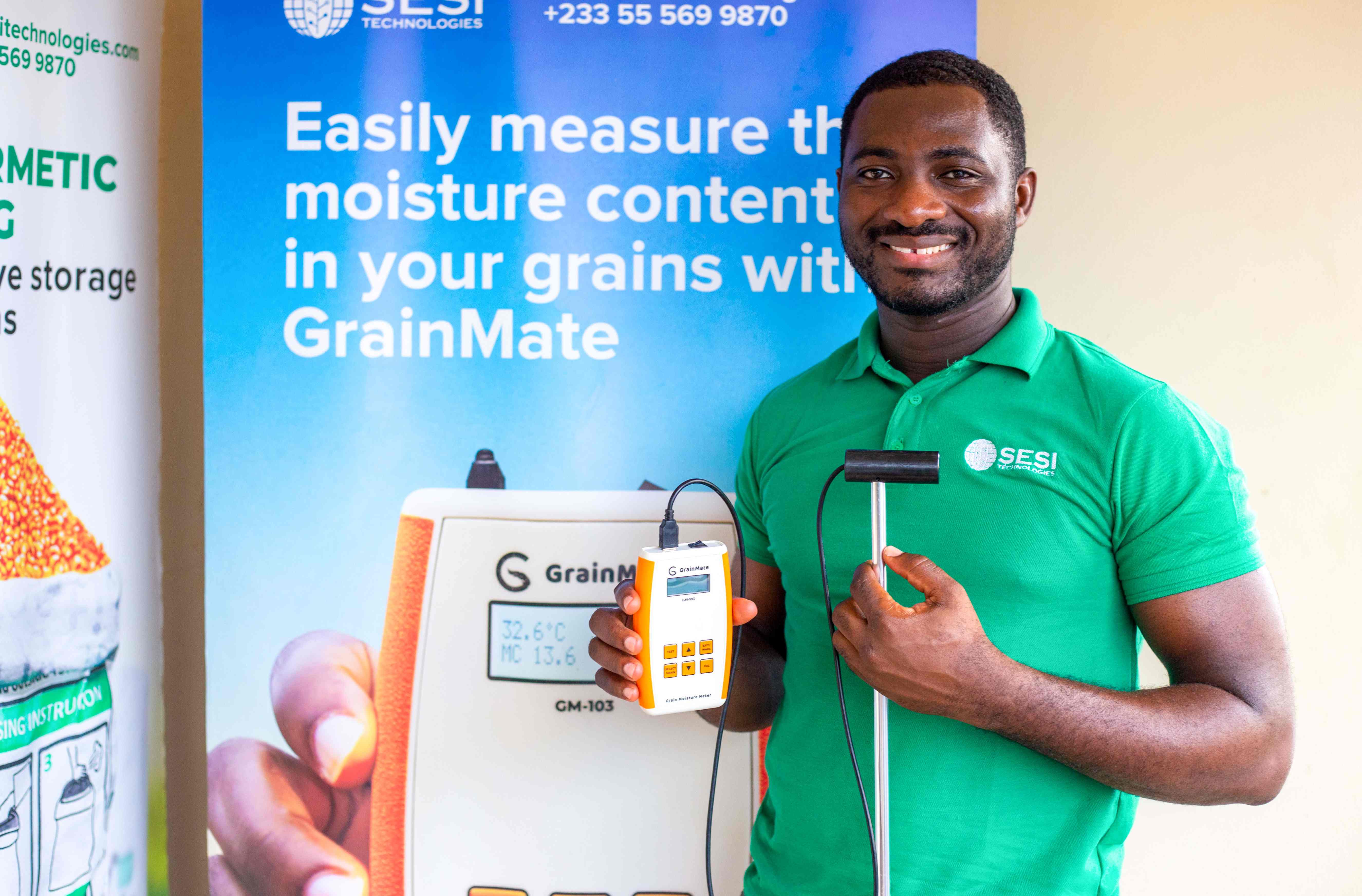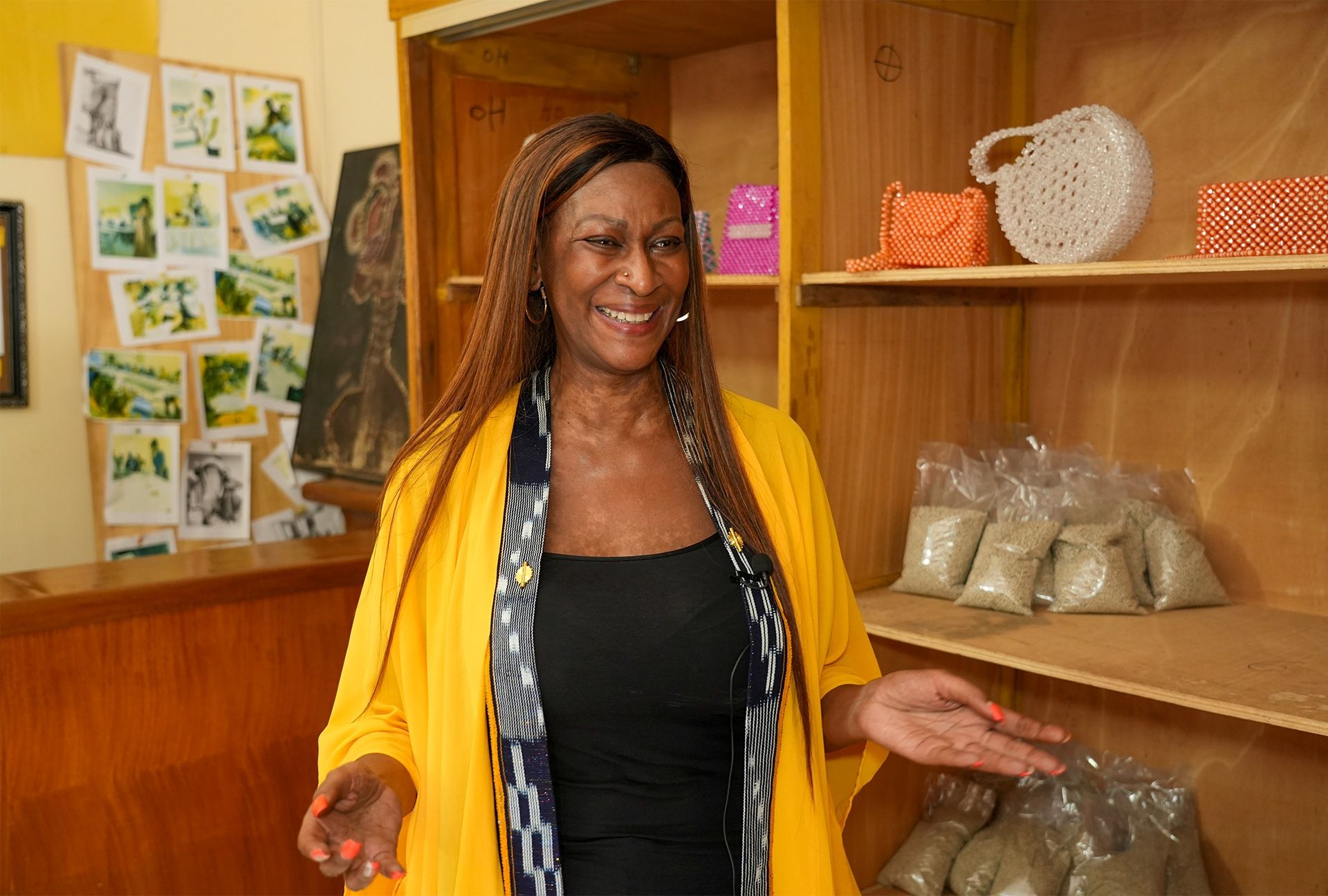Isaac Sesi was determined to see his academic research project make an impact on society. So he called on his first-hand experience of food loss. The result, a device to measure moisture in stored produce like maize, now competes with imported devices to assist local farmers.

Sefakor Fekpe, bird story agency
Isaac Sesi picks up a small bucket of maize to demonstrate the latest iteration of his moisture-measuring device. Powering the device with batteries, he presses a button. A white screen shows the types of grain to select for the test; he selects the maize category and then presses another button to take the reading. Sesi is demonstrating the latest model of the GrainMate moisture meter, his solution to countering food loss in rural farming communities.
"Moisture content is one of the physical quantities that are essential in determining the quality of your end product, so we have come up with the GrainMate to make it easy to know how much moisture content you have in your product,” Sesi explained.
As a young man from a farming community in the Ashanti region of Ghana, Sesi became familiar with the challenges of storing grain the hard way, witnessing the difficulties his parents and other farmers experienced when trying to store their farm produce. He dedicated his academic career to finding a solution to this food loss.
His first iteration of the device was completed in 2018. The idea was to help farmers, aggregators, feed producers and anyone in the grain value chain to easily measure moisture content in their grain before storage, feed preparation or processing.
“One aspect of food security is in the process of being able to reduce or mitigate post-harvest losses because 30 per cent of the food that we produce is lost and if we can cut down on these losses, that will bode well for our food security because the food that is being lost is food that can feed other people,” Sesi shared.
Currently, Sesi Technologies’ GrainMate is less expensive compared to other, imported, moisture meter brands.
Sesi's company offers two models. One is for regular grains, which is sold at 800 Ghanaian cedis (about US$65) while a second model extends to high-value commodities such as shea nuts. That version costs 1000 Ghanaian cedis (about US$83).
Sesi graduated from Kwame Nkrumah University of Science and Technology (KNUST) and used his final year research project to come up with the GrainMate.
“In Ghana, with research, you just finish and put it on the shelf so you move on with your life but we thought that we developed something pretty good and we wanted to make it beneficial to farmers so I started Sesi Technologies to commercialise the output of my research at KNUST,” Sesi said.
The company's breakthrough came with a sale of 150 of the devices. Since then, Sesi has depended on revenue from sales of moisture metres and other services, while his company has received funding from a range of sources.
“We started with no money, absolutely no money. We just started by trying to commercialise this technology and how we were able to manufacture our first batch was that we got some pre-orders so we asked the client to pay for 70% so that we could use it to finance the initial inventory,” Sesi shared.

Sesi was determined to reach as many farmers as he could, which pushed him to participate in different start-up support programmes. He emerged as the overall winner of the GoGettaz Agripreneur Prize, an award for African agri-food innovators and entrepreneurs who are developing solutions for the agriculture value chain, in 2019.
“We won the overall US$50,000 prize."
This prize helped him to scale both production and human resources.
“We have about 25 people in our team and that tells you that our wage bill every month is substantial and we’re making progress. We also have our field team who are in charge of providing the services that we provide to farmers,” he explained.
Over 5,000 farmers have now tried out the device, with uptake still slower than he and his team of mostly 20-somethings would like.
“There’s very slow adoption to new technology and so we have not seen the kind of rapid adoption that we are looking for,” he explained.
However, feedback from the current pool of users keeps Sesi and his team motivated.
“For instance, poultry farmers use our device to check the moisture content of the different components of the feed before they put it together. When they do that they tell us that once they know the moisture content they see the quality of the feed is high, productivity is high and their birds don’t suffer from diseases because our device helps them.
“There was a time when the device was not there to check the right moisture for storage, I bagged the maize thinking that they were safe but when I needed them at a point to use them they were all green in the bag and I lost a lot of money," explained Kofi Korsah, a commercial maize and poultry farmer and one of Sesi Technologies’ clients.
Joseph Oppong Akowuah, a local professor and expert in post-harvest management who uses the device to educate farmers explained the importance of having young entrepreneurs like Sesi innovate and sell local solutions.
“It can help farmers move away from the indigenous approach of checking the level of moisture in their produce by using a scientific approach...These are very critical," he explained.
Akowuah believes the government’s support for entrepreneurs like Sesi under the Planting for Food and Jobs (PFJ), an initiative aimed at increasing production and increasing revenue for farmers, will have a far-reaching impact.
“If we want to get this technology on a wide scale, there must be some kind of policy intervention from the government because I think one of the critical issues has to do with training, exposure, and making farmers aware of some of these technologies," he advised.
Sesi is optimistic about growth and is eyeing a local manufacturing facility employing skilled engineers to increase production capacity and push mass adoption of the GrainMate device.
“In the end, the goal is to be able to produce and assemble more," he said.
bird story agency




